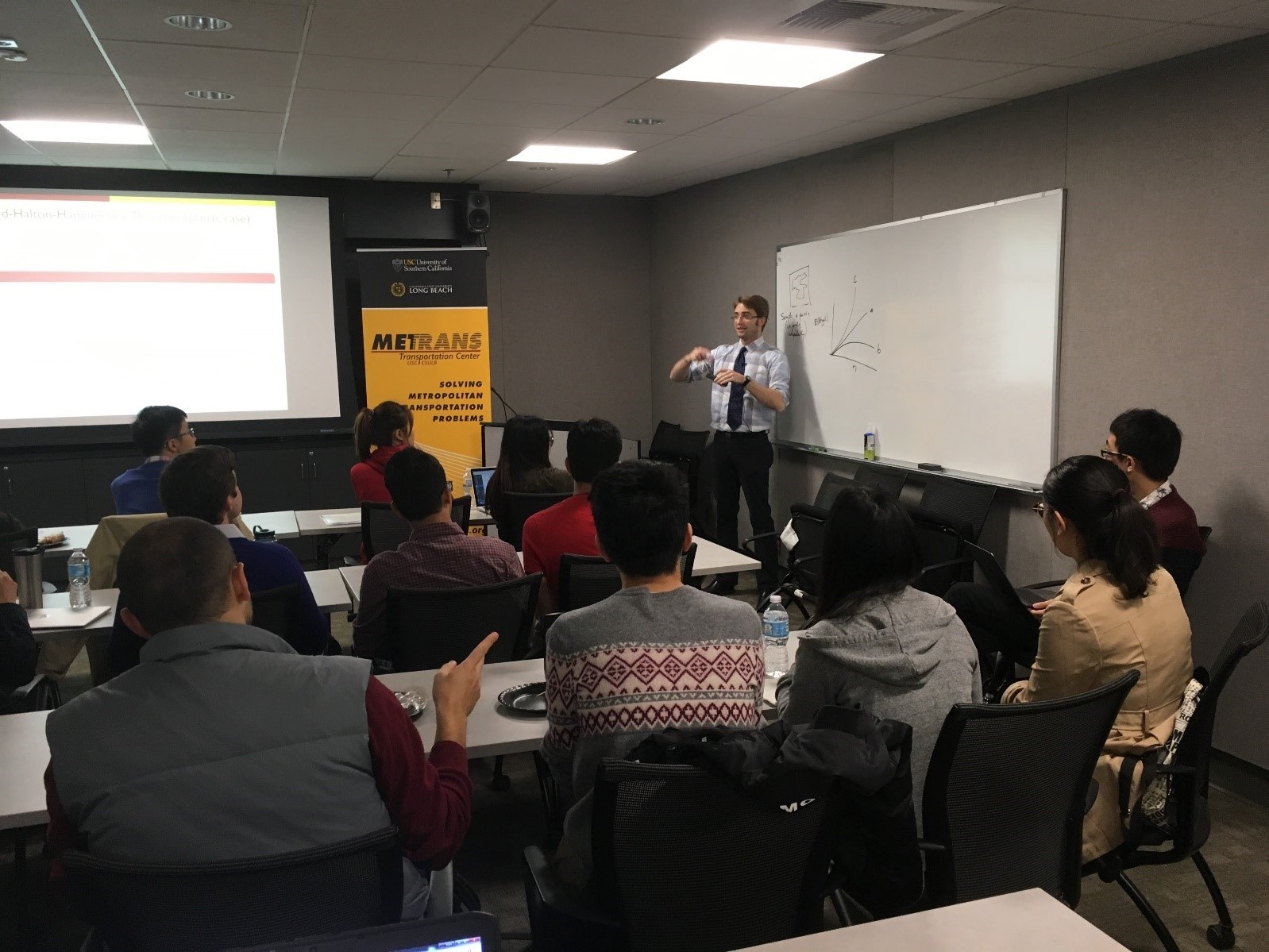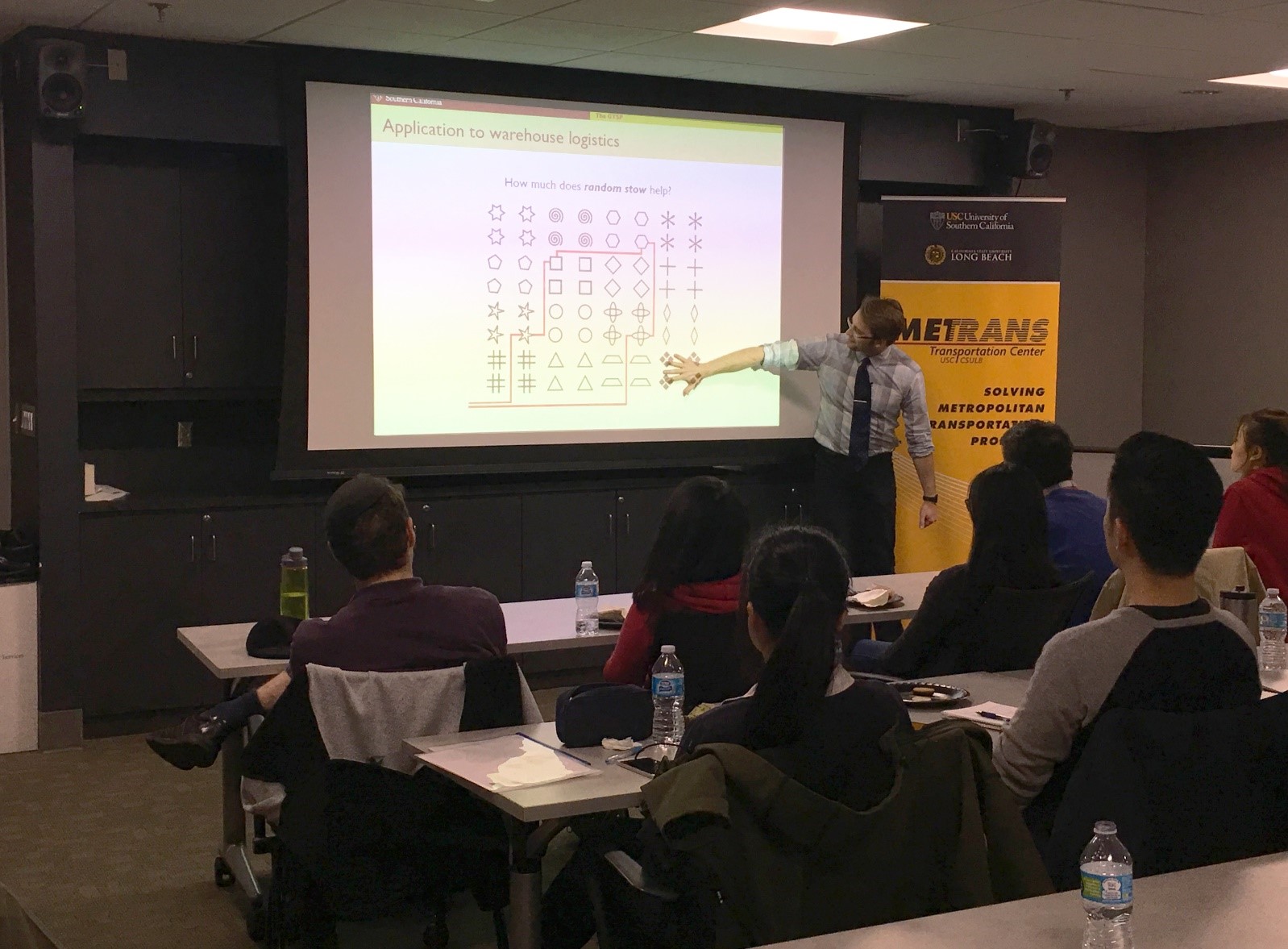News | METRANS Research Seminar Series: Quantifying the Impact of Next-Gen Modes of Delivery
Stop the VideoNews

METRANS UTC
METRANS Research Seminar Series: Quantifying the Impact of Next-Gen Modes of Delivery
Thursday, February 2, 2017
Shichun Hu, MSISE 2017

Photo by Joseph Ritzman, SSA Marine
On January 18th, METRANS kicked off its Spring 2017 Research Seminar series with USC ISE Professor John Carlsson presenting his research, “Quantifying the Impact of Next-Generation Modes of Delivery.”
“A new delivery paradigm has emerged for transporting goods on the so-called last mile to households, pioneered by such services as Google Shopping Express, Amazon Prime, Instacart, and Walmart To Go, among others,” Carlsson shared. “Such services reduce the need for households to travel because one can simply order products online and have them delivered quickly to one’s doorstep. However, it is not yet understood (or, more specifically, quantified) to what degree such services result in social benefits vis-a-vis congestion and carbon emissions.” The objective of his research project, he explained, is to apply tools from geospatial analysis, geometric probability theory, and mathematical optimization to develop an integrated model that predicts the changes in congestion and carbon footprint that result when households in a geographic region adopt (or reject) such delivery services.
Carlsson began the seminar with an introduction to how delivery modes have impacted people’s lives such as the growing impact of parcel delivery (UPS, FedEx, etc.) and grocery delivery (Amazon Prime, Instacart, etc.). Then, in order to better explain his main discovery, he introduced the well-known example of the Travelling Salesman Problem (TSP) and shared several pictures of delivery modes to pique the attendees’ interests. A TSP asks the following question: "Given a list of cities and the distances between each pair of cities, what is the shortest possible route that visits each city exactly once and returns to the origin city?" It is an NP-hard problem in combinatorial optimization, important in operations research and theoretical computer science [1]. Expanding on the concept, he introduced the problem his project was addressing, called the Generalized Travelling Salesman Problem (GTSP). A GTSP is an extension of the Traveling Salesman Problem (TSP), where the node set is partitioned into clusters, and the objective is to find the shortest cycle that visits exactly (or, in some variations at least) one node in each cluster [2].

Source: Photo by Deng Yang, USC
After presenting some real-world situations to which GTSP applies, Carlsson concluded that in their research, they found “a considerable amount of adoption of delivery services is necessary before one begins to see a decrease in carbon footprint.” This was shown in the table below where we can conclude that: 1) With same average population per store, the more errands (n) one needs to run with one route, the higher possibility where you will get carbon benefits from adopting home deliveries; 2) With same errands (n), the higher average population you have for each store, the more you will benefit from adopting home deliveries. During the speech, a number of ideas were exchanged between Professor Carlsson and the attendees, pertaining to both the delivery situations as well as the project result.

Source: METRANS Research Project 15-14 Final Report
Joseph Ritzman, Vice President at SSA Marine, traveled from Seattle to attend the event. “As a 20-year practitioner in the field of supply chain logistics, it’s always informative and rewarding to keep a pulse on what are the new ideas and approaches being researched and developed,” he noted, “particularly when they come from a top-notch institution like USC’s METRANS Transportation Center.”
For more information on this research, please click here.
References
[1] https://en.wikipedia.org/wiki/Travelling_salesman_problem
[2] http://www.cs.nott.ac.uk/~pszdk/gtsp.html
John Carlsson
John Gunnar Carlsson, Ph.D., is an assistant professor in the Epstein Department of Industrial and Systems Engineering of USC’s Viterbi School of Engineering. He received his Ph.D. from the Institute for Computational and Mathematical Engineering (ICME) at Stanford University in 2009 and his A.B. in mathematics and music from Harvard College in 2005. Prof. Carlsson works on algorithms for solving problems in continuous location theory, and more generally, optimization problems with geographic aspects. His research is supported by DARPA, the Office of Naval Research, the Air Force Office of Scientific Research, the National Science Foundation, and the US Department of Transportation, and he was previously supported by an NSF GOALI grant, the Minnesota Department of Transportation, and the Boeing Company.
Shichun Hu
Author Shichun Hu is a student assistant at METRANS Transportation Center specializing in research project administration and coordination of the METRANS Mentor Program. She is a 2nd year graduate student majoring in Industrial and System Engineering in the Viterbi School of Engineering, USC. Her interests are using data and operation research methods to improve urban logistics and the supply chain. She is pursuing analytical internships in these fields. Shichun can be reached at [email protected].
News Archive
- December (1)
- November (6)
- October (4)
- September (2)
- August (3)
- July (4)
- June (3)
- May (7)
- April (8)
- March (11)
- February (8)
- January (7)
- December (7)
- November (8)
- October (11)
- September (11)
- August (4)
- July (10)
- June (9)
- May (2)
- April (12)
- March (8)
- February (7)
- January (11)
- December (11)
- November (5)
- October (16)
- September (7)
- August (5)
- July (13)
- June (5)
- May (5)
- April (7)
- March (5)
- February (3)
- January (4)
- December (4)
- November (5)
- October (5)
- September (4)
- August (4)
- July (6)
- June (8)
- May (4)
- April (6)
- March (6)
- February (7)
- January (7)
- December (8)
- November (8)
- October (8)
- September (15)
- August (5)
- July (6)
- June (7)
- May (5)
- April (8)
- March (7)
- February (10)
- January (12)















